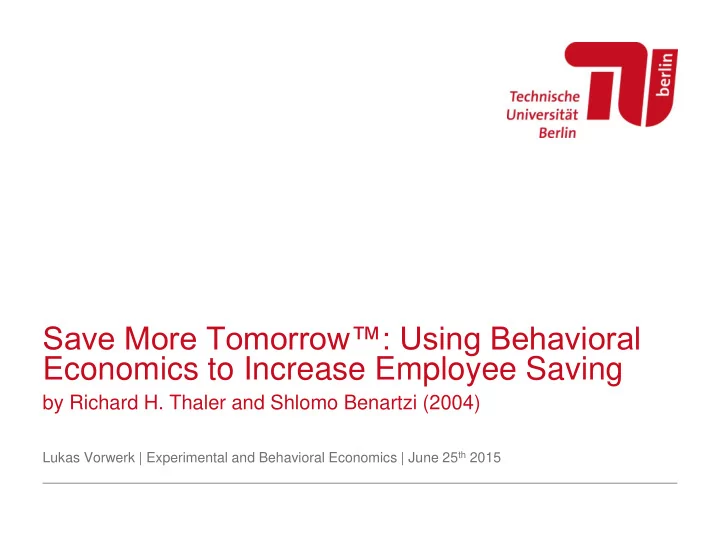

Save More Tomorrow™: Using Behavioral Economics to Increase Employee Saving by Richard H. Thaler and Shlomo Benartzi (2004) Lukas Vorwerk | Experimental and Behavioral Economics | June 25 th 2015
Agenda 1. Introduction 2. Behavioral economics and saving 3. The SMarT program 4. Additional simulations 5. Conclusions Save More Tomorrow™: Using Behavioral Economics to Increase Employee Saving | L. Vorwerk | June 29th 2015 page 2
1. Introduction Life cycle theory of saving Defined-benefit plan Defined-contribution plan No willpower or self-control Employees have to actively needed join and select their own savings rates Evidence: some employees contribute little or nothing Goal: Design a program based on principles from psychology and behavioral economics to help people save more Save More Tomorrow™: Using Behavioral Economics to Increase Employee Saving | L. Vorwerk | June 29th 2015 page 3
2. Behavioral economics and saving Reasons for too little savings Determining the optimal savings rate is difficult Saving requires self-control Procrastination: tendency to postpone unpleasant tasks Behavioral factors Hyperbolic discounting Time-inconsistent behavior Weighing current and near-term consumption especially heavily Procrastination Status quo bias / inertia Tendency to like things to stay relatively the same Loss aversion Tendency to weigh losses significantly more heavily than gains Save More Tomorrow™: Using Behavioral Economics to Increase Employee Saving | L. Vorwerk | June 29th 2015 page 4
3. The SMarT program Main elements Time-lag between sign-up and first contribution to the plan as long as possible Contribution to the plan is only increased after pay raises Contribution rate continues to increase on each scheduled pay raise until a preset maximum is reached The employee can opt out of the plan at any time Implementation Implemented in three firms Implementation varied between firms Interaction with financial advisor One-shot mailing Financial education seminars Particular design features vary as well Save More Tomorrow™: Using Behavioral Economics to Increase Employee Saving | L. Vorwerk | June 29th 2015 page 5
3. The SMarT program (cont’d) Results: 1 st implementation High take-up rate rate Majority of participants remained in the plan (80%) Participants ended up with a much higher saving rate than the rest Save More Tomorrow™: Using Behavioral Economics to Increase Employee Saving | L. Vorwerk | June 29th 2015 page 6
3. The SMarT program (cont’d) Results: 2 nd & 3 rd implementation Moderate take-up rates (13.4% & 26.5%) Low dropout rates at Philips (5.4%) Increasing in saving rates as expected Save More Tomorrow™: Using Behavioral Economics to Increase Employee Saving | L. Vorwerk | June 29th 2015 page 7
4. Additional simulations Widespread adoption Savings Adequacy Calculations for hypothetical Representative data from workers retirement saving administrators Different age and income profiles Calculations for three hypothetical Including social security and savings implementation strategies and through defined-contribution plans different annual increments Replacement rates near 100% Many other assumptions on assumed as adequate dropout rates etc. Save More Tomorrow™: Using Behavioral Economics to Increase Employee Saving | L. Vorwerk | June 29th 2015 page 8
5. Conclusions The first experiences with the SMarT plan have been quite successful Relatively high enrollment rates • Depends on the specific implementation strategy Low dropout rates Great (but adequate) increase in saving rates Recipe for success: SMarT makes use of the same principles that typically prevent people from saving Behavioral economics can be used to design effective prescriptive programs for important economic decisions Save More Tomorrow™: Using Behavioral Economics to Increase Employee Saving | L. Vorwerk | June 29 th 2015 page 9
Thank you for your attention! Save More Tomorrow™: Using Behavioral Economics to Increase Employee Saving | L. Vorwerk | June 29th 2015 page 10
Recommend
More recommend